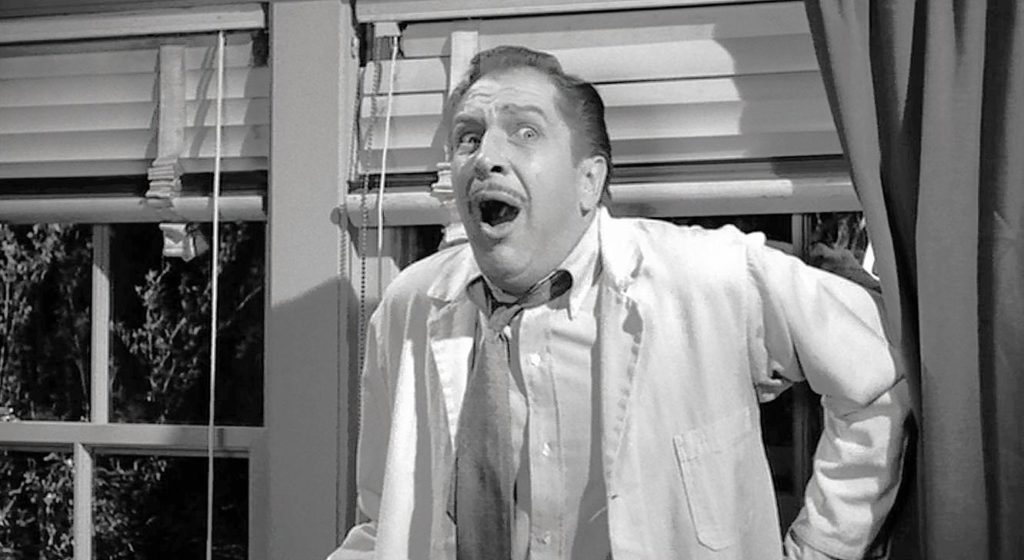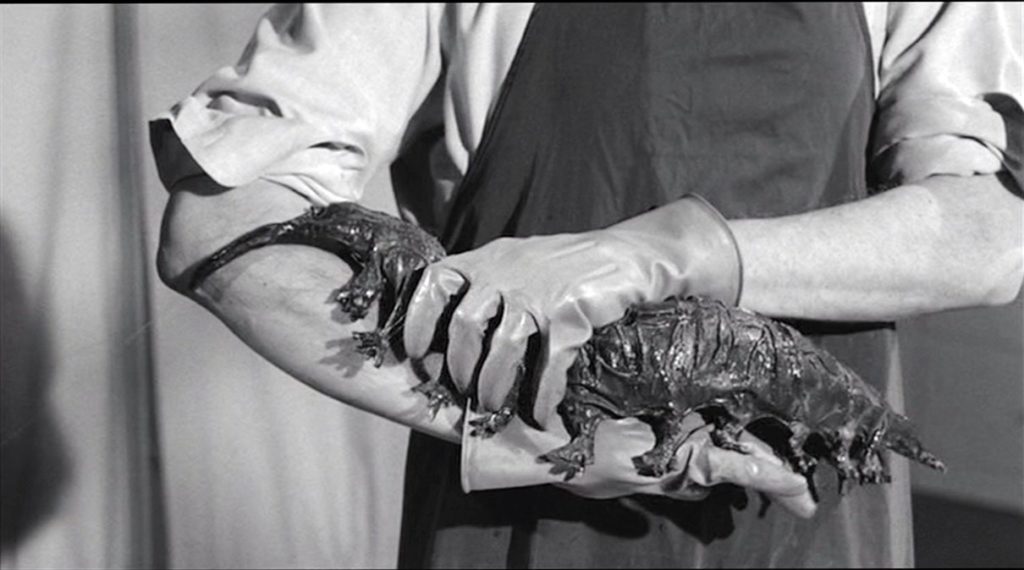Grossing over $2million off a $400,000 budget, The Tingler was a huge money-spinner for producer William Castle. The plot is, in the main, misogynistic melodrama, and the solitary monster is just over a foot long. However, Castle’s showmanship, Vincent Price’s performance, and a unique LSD-trip sequence take it to another level.
In the second of two movies Price made with Castle that year, he plays Dr. Warren Chapin, a gentleman-scientist fascinated by the concept of fear. While autopsying the bodies of executed prisoners he has observed that the vertebrae crack at the moment of execution, as though under some immense pressure which has nothing to do with the electrocution. He believes in a force that manifests at the base of the human spine at moments of extreme terror and becomes obsessed with proving its existence. He dubs that force ‘the Tingler’.

Like all good mad scientists, Chapin has a home laboratory (paid for by his alcoholic, unfaithful wife, Isabel) where he and his young apprentice, David conduct experiments on fear in living things. Chapin needs human subjects, however, as the cats David kidnaps from alleys aren’t cutting it anymore. He conducts a cruel experiment on Isabel, deliberately terrifying her by threatening her and shooting her with a blank bullet. He X-rays her while she’s unconscious and discovers a suspicious mass at the base of her spine— proof he is on the right track.
Self Medication
Chapin then experiments on himself. He declares that he is too logical and sensible to feel fear under normal circumstances, so, in an unlikely sequence for 1959, he doses himself with LSD (it was still legal to do so at the time) and records his reaction to the subsequent hallucinations. This marks LSD’s first screen appearance — the screenwriter Robb White heard about it from Aldous Huxley and went to UCLA to try it for himself. Chapin thrashes round in his lab, fearing the walls are closing in on him (eyebrows akimbo, Price is given free rein to chew whatever scenery comes to hand), but, unfortunately, gives in to an almighty scream before the fear reaches its peak.

Thwarted, Price vows to find a test subject who will allow the Tingler to reach its fullest physical manifestation without dissipating its energy with a scream. His eyes light on the wife of Ollie Higgins, a rather odd individual who runs the local silent movie theatre, and who likes hanging out with Dr. Chapin at the autopsy table. Mrs. Higgins is a deaf-mute, physically unable to scream, who loses consciousness at the climax of fear when it all becomes too much for her. Dr. Chapin pays her a visit, discovers she is feeling unwell and gives her a shot that looks suspiciously similar to the LSD he dosed himself with earlier. When she comes round she is threatened by slamming doors, prowling ghouls, and, when she flees to the bathroom for safety, a tub full of lurid red blood — unnerving, in the middle of a black and white film.
Unsurprisingly, she drops dead of terror, and her willing husband brings the corpse up to the friendly neighborhood pathologist, Dr. Chapin. In order to investigate the cause of death he draws screens around his examining table, and in dramatic, full effect silhouette, extracts a monstrous looking shadow from the unfortunate deceased’s spine.
This, when Dr. Chapin brings it from behind the curtain, turns out to be a revolting rubber creature, bastard child of an earwig and a slug. Castle was as tight-fisted as they come when allocating SFX (or any category) budgets, and the Tingler is a crude effect indeed. You can see the wires that pull it around in a number of shots. However, it is surprisingly effective in all its rubber repulsiveness, especially when it attacks Dr. Chapin with its pincers. It’s ugly and phallic enough to inspire nightmares of a most nasty sort.

Chapin, unusually for a mad scientist, realizes he has made a mistake and intones his regret to his young apprentice:
“To break the laws of nature is always a dangerous thing. We’ve not only broken laws, we’ve violated some basic principles. We had to, but now we’re going to stop.”
Chapin is going to have to try to stuff this monster back where it came from, inside Mrs. Higgins – but
The Percepto
The final reel is a remarkable piece of audience participation, bringing the drama onscreen right into the auditorium. Anyone who sees the trailer beforehand knows a little of what to expect, courtesy of a warning from Castle himself:
“For the first time in motion picture history, members of the audience, including you, will actually play a part in the picture. You will feel some of the physical reactions, the shocking sensations experienced by the actors on the screen.”
As it’s 1959, he can’t resist adding a cold war coda to his promise, jamming in as many buzzwords as he can:
“Don’t be alarmed, you can protect yourself. When you see the picture, you will be told, and remember the instructions, how you can guard yourself against attack from… The Tingler.”
Movie theatres showing The Tingler can be kitted out with the Percepto,
“Ladies and Gentlemen, please don’t panic, but SCREAM. Scream for your lives. The Tingler is loose in this theatre. If you don’t scream, it will kill you.”
You bet everyone screams – a good scream is as effective a release as a good laugh, one of the reasons audiences enjoy horror movies so much. There are few other socially acceptable opportunities to scream your lungs out. And screaming is the only way to save yourself and your date from the Tingler…